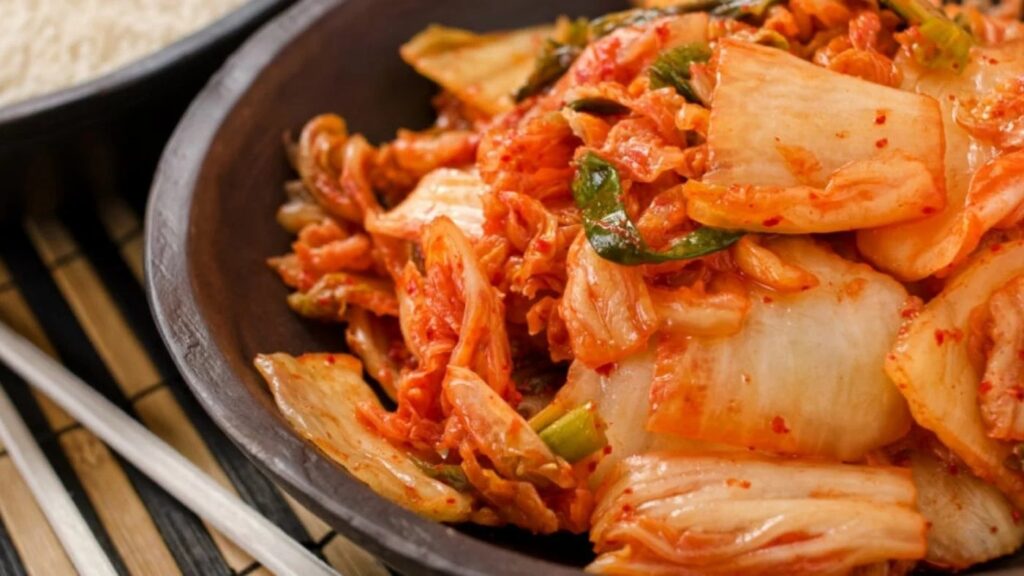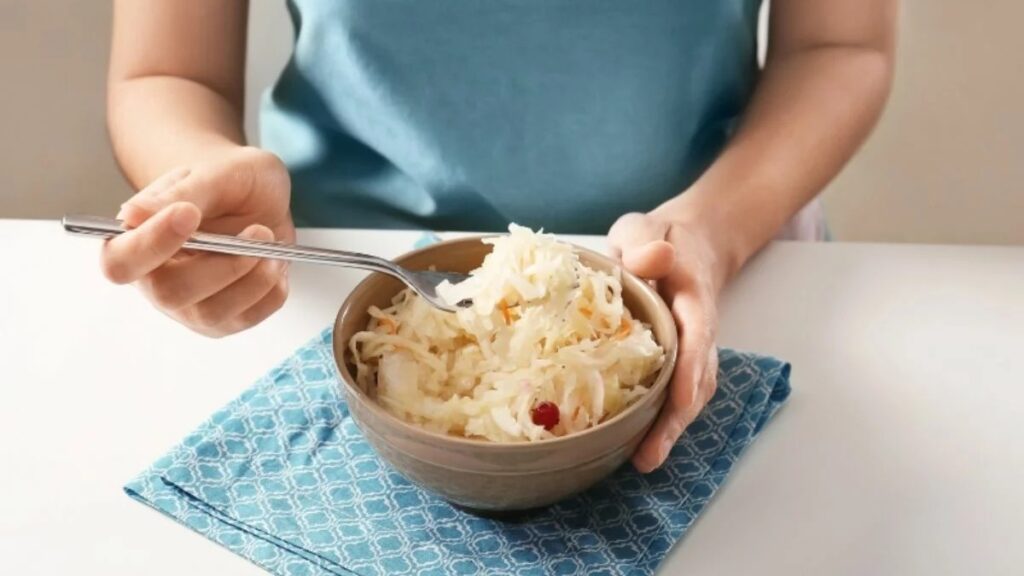We will show you how to make genuine raw (fermented) Alsatian sauerkraut, step by step, according to the purest tradition (and according to the official specifications).
This article will show you how to make raw sauerkraut as well as your Alsatian grandmother! This sauerkraut can be used as an ingredient to prepare the famous choucroute garnie, or simply eaten raw as a condiment.
It is normal to be a bit confused when reading this because the term “sauerkraut” refers to both an ingredient, or rather a condiment, and a dish. They are not the same thing.
Let us explain!
However, jump to the section you are interested in if you want to go faster:
- Raw, Alsatian, or choucroute garnie?
- Where does Alsatian sauerkraut come from?
- Ingredients for sauerkraut
- Equipment for sauerkraut
- Recipe for Alsatian Sauerkraut
- Cooking raw sauerkraut
Alsatian sauerkraut, choucroute garnie, raw sauerkraut: what are the differences?
When we talk about sauerkraut, we can talk about both a ready-made dish and a condiment.
Here are some more accurate definitions:
- Raw sauerkraut: fermented cabbage
- Alsatian raw sauerkraut: raw sauerkraut produced according to the Alsatian tradition.
- Choucroute garnie: dish made from raw sauerkraut and charcuterie.
- Alsatian sauerkraut: sauerkraut cooked according to the Alsatian tradition.
What is raw (fermented) sauerkraut?
Raw sauerkraut is finely cut and salted cabbage that has been lacto-fermented.
Through the work of good bacteria (Lactobacillus), raw cabbage is transformed and becomes tangy and soft. Raw sauerkraut can be prepared with various ingredients in addition to cabbage, such as carrots, apples, onions, and all kinds of spices.
Want to know more about the fermentation of sauerkraut? Check out our Basic Sauerkraut Recipe.
What Is Raw (Fermented) Alsatian Sauerkraut?
When it comes to raw Alsatian sauerkraut, we are talking about fermented (uncooked) sauerkraut that is certified with a Protected Geographical Indication (PGI).
In other words, if you buy raw Alsatian sauerkraut, you know that it has been produced in Alsace and that the producer has followed a traditional process that guarantees its quality.
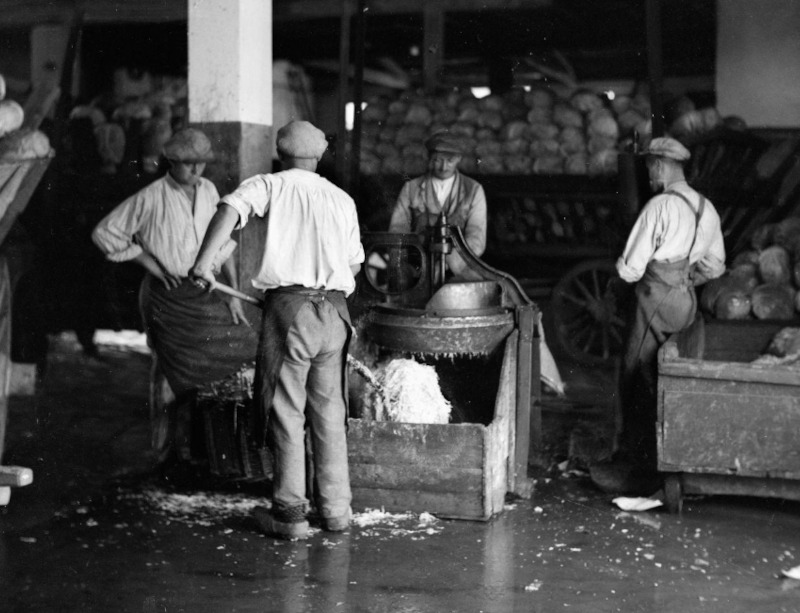
Cabbage cutting in a sauerkraut factory in Strasbourg (Alsace, France), in 1932
To obtain the “Alsatian Sauerkraut” designation, it is necessary to meet the requirements of a precise set of specifications (French PDF). The type of cabbage, the thickness of the strips, and the fermentation method are important to obtain authentic sauerkraut.
Raw Alsatian sauerkraut can be eaten as is, in sandwiches, or as an accompaniment to meals, but its primary function is to be prepared as choucroute garnie.
What Is Choucroute Garnie?
Choucroute garnie is a cooked dish with raw sauerkraut and charcuterie as the main ingredients.
In a large pan, raw sauerkraut is mixed with sausages, potatoes, spices, and wine. The mixture is baked in the oven for a few hours so that all the flavours blend.
The natural acidity of the sauerkraut, the spices, and the wine offset the richness and saltiness of the sausages. It is truly delicious!
Choucroute garnie is emblematic of Alsace and Germany. This dish is served as a sustaining, comforting, and family meal!
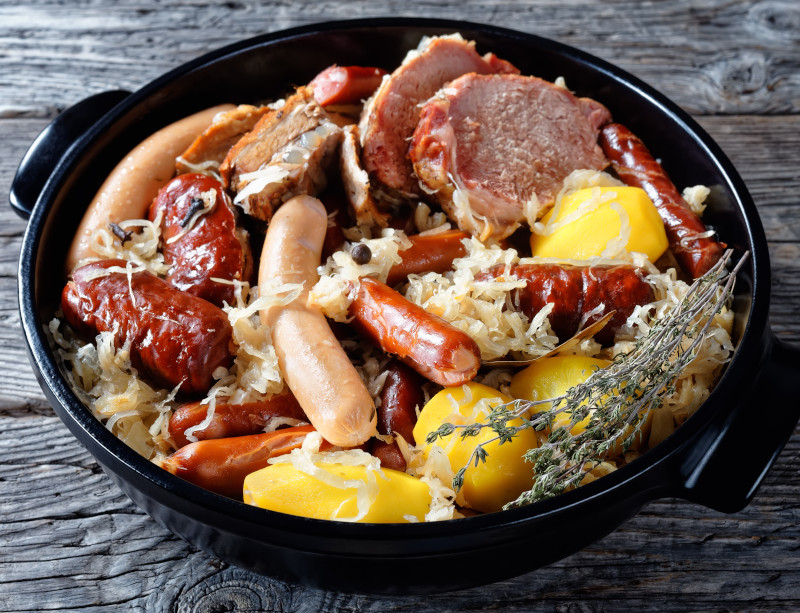
Where Does Traditional Alsatian Sauerkraut Come From?
Although evidence of fermented cabbage can be found all over the world, the first signs of fermented cabbage in France and Germany date back to the 15th century. It was served raw and plain on monastery tables as a cheap, long-lasting, and delicious basic food.
The Germans called it “sauerkraut”, which means “sour cabbage”. The Alsatians called it “sürkrut”, which literally means “sour grass”.
In the course of history, Alsace was successively annexed to Germany and France. Alsatian sauerkraut, German sauerkraut… so it’s pretty much the same thing!
The cultivation of cabbage and the production of sauerkraut are mainly developed in Alsace. This region’s rich soil is ideal for growing cabbage. Its harsh winters have led the inhabitants to preserve cabbage in the form of sauerkraut to survive the cold weather.
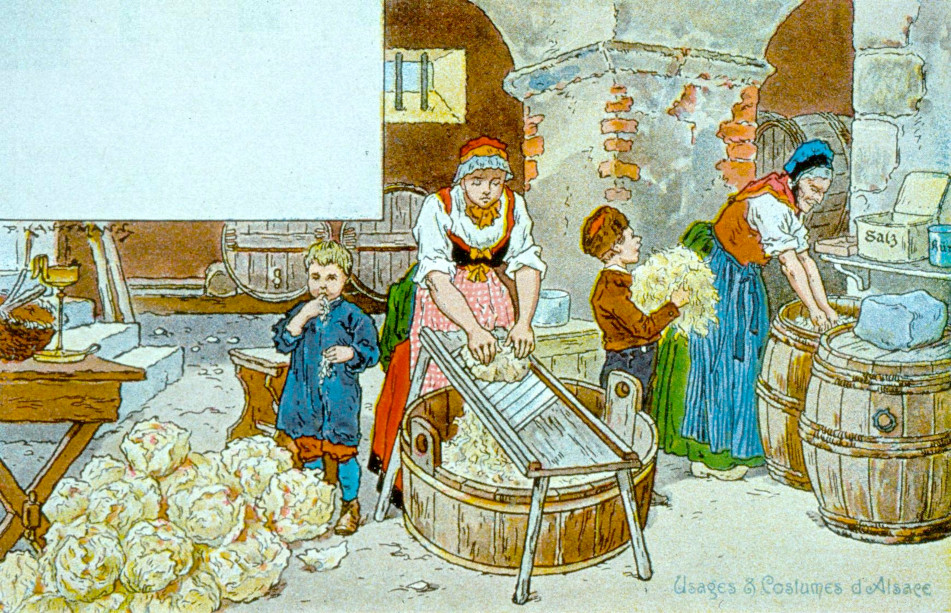
Paul Kauffmann – Making Sauerkraut. Usage and Customs in Alsace, 1902
In the 19th century, sauerkraut began to be served in taverns, together with charcuterie. This is where the choucroute garnie was born!
Alsatian sauerkraut spread throughout France and the world! Moreover, Alsace still produces 70% of the sauerkraut consumed in France. (ref.)
Since 2018, Alsatian sauerkraut benefits from a Protected Geographical Indication (IGP). Only local producers can market this type of sauerkraut, and only if they meet the requirements of the specifications.
What Ingredients Are Used in Raw Alsatian Sauerkraut?
According to the official specifications, Alsatian sauerkraut contains only two ingredients: cabbage and salt!
Cabbage
The best cabbages for Alsatian sauerkraut are white and green cabbage, which give the sauerkraut a pale and uniform colour.
To qualify for certification, the cabbages used for Alsatian sauerkraut must come from the Alsace region and weigh a minimum of 3kg. We promise we won’t tell if you take a nice cabbage from the supermarket ;)
For best results, the cabbage must be very fresh. It also needs to be cut into very thin strips. If you are using a mandoline, set it to between 0.6mm and 1mm.
Salt
The salt used should contain only one ingredient: “salt”.
Avoid salt that contains additives, iodine, or anticaking agents. Sea salt and pickling salt are good options.
To meet Alsatian sauerkraut standards, the amount of salt should be between 1 and 2.5%. Professional sauerkraut makers know how to adjust the amount of salt added according to the season, to obtain the best results. Sauerkraut is saltier in summer and less in winter.
Our recipe contains 2% salt, which works well any time of the year.
See How much salt to use for lacto-fermentations for more information.
Spices
In the traditional Alsatian sauerkraut recipe, spices are added when the sauerkraut is cooked. The sauerkraut is fermented plain, without the addition of spices.
If you intend to use your sauerkraut as a condiment, you can add a bay leaf, a few peppercorns, and juniper berries to your chopped cabbage before fermenting it.
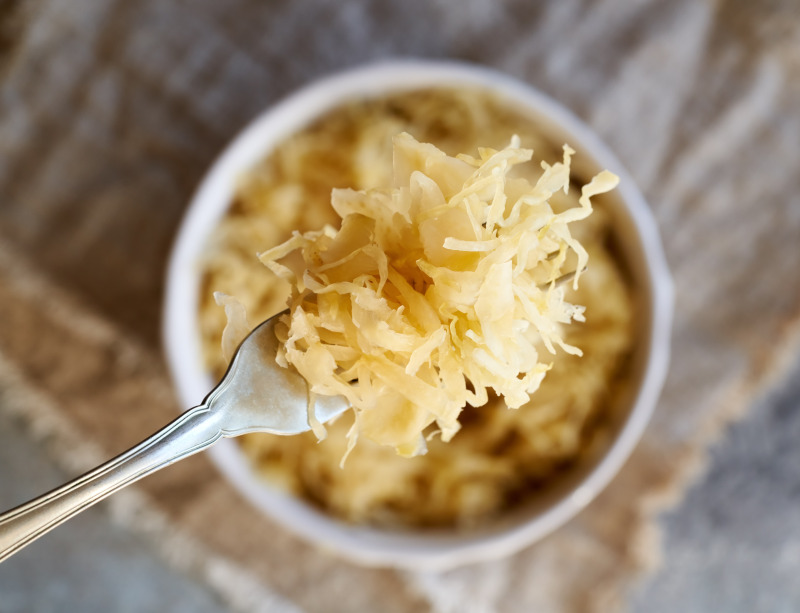
Steps for Making Raw Alsatian Sauerkraut
Raw Alsatian sauerkraut is traditionally lacto-fermented. Its preparation involves four main steps:
- Cut the cabbage
- Salt the cabbage
- Put it in jars
- Let it ferment
For more information, see our complete guide to making sauerkraut or our guide to making lacto-fermented vegetables.
Equipment for Making Raw Sauerkraut
Alsatian sauerkraut used to be fermented in huge wooden fermentation tanks! To prepare it at home, you need very little equipment:
- A glass jar. We recommend Le Parfait jars. The lever lids and rubber rings are perfect to let the CO2 out of the fermentation, without letting oxygen in.
- A weight to cover the cabbage. We recommend glass weights or a ViscoDisc insert. They keep the sauerkraut well submerged under the brine.
- A mandoline. To obtain the typical Alsatian sauerkraut strips, use a mandoline or a very sharp knife.
Take a look at our sauerkraut kit to get the equipment or check out our guide to choosing your fermentation equipment.
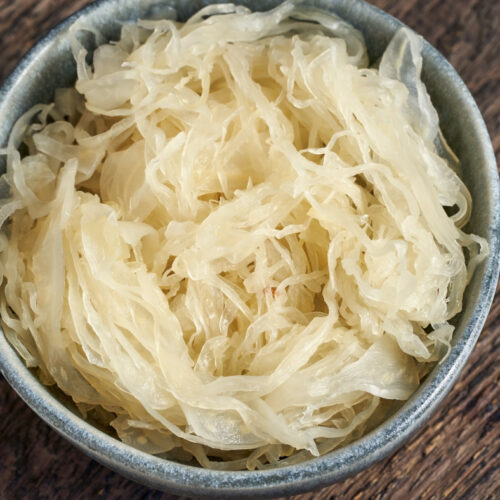
Traditional Raw Alsatian Sauerkraut Recipe
Equipment
- 1 Large mixing bowl
- 1 Pickle packer tamper optional
Ingredients
- 1 kg cabbage
- 20 g salt
Steps
Preparation of the vegetables
- Gather the ingredients and equipment.
- Lightly rinse the cabbage and remove any dirty or damaged parts.
- Tear off a large cabbage leaf and set it aside for later.
- If your mandoline allows it, set the blade to 1 mm.
- Slice the cabbage very thinly. Place in a large bowl. Discard the core of the cabbage.
- Sprinkle the salt over the cabbage.
- Mix very well with your hands (about 1 minute).
- Allow soaking for at least 15 minutes.
- Mix again for 1 minute with your hands. The cabbage will release some of its water.
Putting in Jar
- Fill the jar with cabbage. Squeeze well as you go along.
- Fill the jar up to 4 cm (1.5 inches) from the rim.
- Place the reserved cabbage leaf on top and press well. It helps protect the vegetable chunks from oxygen. This leaf will not be eaten.
- Place the insert on top of the cabbage leaf, folding the sides upwards.
- Add water if the vegetable juice does not cover the cabbage leaf.
- Close the lid of the jar.
Fermentation
- Place the jar on a large plate in case it overflows during fermentation.
- Store the jar unopened at room temperature for 3 weeks.
Notes
How to Cook Traditional Alsatian Sauerkraut?
Alsatian sauerkraut can be served raw or cooked. It is emblematic of the famous choucroute garnie.
To make choucroute garnie, the first step is to rinse the raw sauerkraut to remove excess acidity. The longer your sauerkraut has fermented, the more rinses are needed (1 to 3 are sufficient).
Next, fry an onion in a large pot, then add the sauerkraut, smoked pork, sausages, ham, white wine (Riesling ideally), and juniper berries. Cook for 2 hours on low heat. The potatoes are cooked separately in water in a saucepan and added at the end.
Choucroute garnie always tastes better the next day when reheated.
Serve Alsatian sauerkraut accompanied by white wine, if possible, from Alsace. Gewurztraminer, Riesling, and Pinot gris are the main wines of Alsace.
